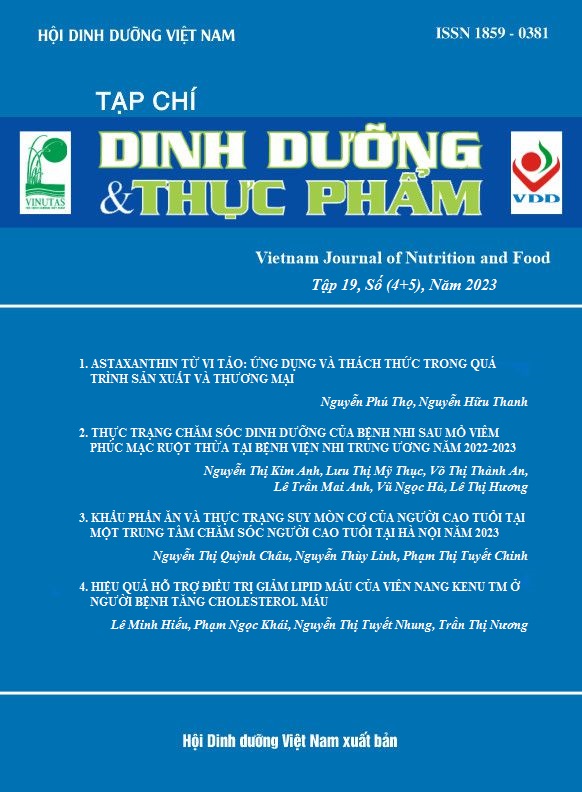KHẨU PHẦN ĂN VÀ THỰC TRẠNG SUY MÒN CƠ CỦA NGƯỜI CAO TUỔI TẠI MỘT TRUNG TÂM CHĂM SÓC NGƯỜI CAO TUỔI TẠI HÀ NỘI NĂM 2023
Nội dung chính của bài viết
Tóm tắt
Mục tiêu: Mô tả khẩu phần ăn thực tế, đánh giá thực trạng suy mòn cơ và mối liên quan đối với khẩu phần của người cao tuổi tại trung tâm chăm sóc người cao tuổi năm 2023.
Phương pháp: Nghiên cứu cắt ngang trên 100 người cao tuổi đang được chăm sóc toàn thời gian tại Trung tâm chăm sóc người cao tuổi Tuyết Thái tại huyện Đông Anh, thành phố Hà Nội từ tháng 1 đến tháng 6 năm 2023.
Kết quả: Giá trị trung vị (khoảng tứ phân vị) của năng lượng khẩu phần là 1304,2 (1092,7-1462,5) kcal/ngày, đạt 84% nhu cầu khuyến nghị (NCKN). Giá trị trung vị (khoảng tứ phân vị) của glucid, protein và lipid lần lượt là 175,9 (149,8-217,2), 52,6 (42,5-61,7) và 38,5 (34,0-39,6) g/ngày, và đạt 78,9%, 97,7% và 88,9% NCKN. Phần lớn đối tượng không đạt NCKN về vitamin và khoáng chất. Có 69,0% đối tượng nghiên cứu có nguy cơ mắc suy mòn cơ. Có mối liên quan giữa lượng protein ăn vào và tuổi của người cao tuổi với nguy cơ suy mòn cơ.
Kết luận: Người cao tuổi có khẩu phần ăn thiếu về cả năng lượng, vitamin và khoáng chất. Nguy cơ mắc suy mòn cơ ở người cao tuổi còn khá cao và có liên quan đến khẩu phần protein và tuổi của người cao tuổi.
Từ khóa
Khẩu phần ăn, suy mòn cơ, người cao tuổi
Chi tiết bài viết
Tài liệu tham khảo
2. Tổng cục thống kê. Người Cao Tuổi Việt Nam: Phân tích từ Điều tra Biến động dân số và Kế hoạch hóa gia đình năm 2021. Published online 2021.
3. McKeever L, Farrar IC, Sulo S, Partridge J, Sheean P, Fitzgibbon M. Nutritional adequacy and oral nutritional supplementation in older community-dwelling adults. J Aging Res & Lifestyle. Published online 2019:1-8. doi:10.14283/jarcp.2019.2
4. Ter Borg S, Verlaan S, Mijnarends DM, Schols JMGA, de Groot LCPGM, Luiking YC. Macronutrient Intake and Inadequacies of Community-Dwelling Older Adults, a Systematic Review. Ann Nutr Metab. 2015;66(4):242-255. doi:10.1159/000435862
5. Molnár A, Jónásné Sztruhár I, Csontos ÁA, Ferencz C, Várbíró S, Székács B. Special nutrition intervention is required for muscle protective efficacy of physical exercise in elderly people at highest risk of sarcopenia. Physiol Int. 2016;103(3):368-376. doi:10.1556/2060.103.2016.3.12
6. Lin CC, Shih MH, Chen CD, Yeh SL. Effects of adequate dietary protein with whey protein, leucine, and vitamin D supplementation on sarcopenia in older adults: An open-label, parallel-group study. Clinical Nutrition. 2021;40(3):1323-1329. doi:10.1016/j.clnu.2020.08.017
7. Yang LJ, Wu GH, Yang YL, et al. Nutrition, Physical Exercise, and the Prevalence of Sarcopenia in Elderly Residents in Nursing Homes in China. Med Sci Monit. 2019;25:4390-4399. doi:10.12659/MSM.914031
8. Malmstrom TK, Miller DK, Simonsick EM, Ferrucci L, Morley JE. SARC‐F: a symptom score to predict persons with sarcopenia at risk for poor functional outcomes. J Cachexia Sarcopenia Muscle. 2016;7(1):28-36. doi:10.1002/jcsm.12048.
9. Chen LK, Woo J, Assantachai P, et al. Asian Working Group for Sarcopenia: 2019 Consensus Update on Sarcopenia Diagnosis and Treatment. J Am Med Dir Assoc. 2020;21(3):300-307.e2. doi:10.1016/j.jamda.2019.12.012
10.Lardiés-Sánchez B, Sanz-París A, Pérez-Nogueras J, Serrano-Oliver A, Torres-Anoro ME, Cruz-Jentoft AJ. Influence of nutritional status in the diagnosis of sarcopenia in nursing home residents. Nutrition. 2017;41:51-57. doi:10.1016/j.nut.2017.03.002
11.Wang L, Zhang B, Wang H, Du W, Zhang J, Wang Z. Intakes of energy and macronutrient among the elderly in nine provinces( autonomous region), China during 1991-2015]. Wei Sheng Yan Jiu. 2019;48(5):700-705.
12.Han G, Yang E. Status of health and nutritional intake of the elderly in long-term care facilities: focus on Gwangju Metropolitan City. J Nutr Health. 2020;53(1):27-38. doi:10.4163/jnh.2020.53.1.27
13.Welch AA, Skinner J, Hickson M. Dietary Magnesium May Be Protective for Aging of Bone and Skeletal Muscle in Middle and Younger Older Age Men and Women: Cross-Sectional Findings from the UK Biobank Cohort. Nutrients. 2017;9(11):1189. doi:10.3390/nu9111189
14. Liu Z, Zhao L, Man Q, Wang J, Zhao W, Zhang J. Dietary Micronutrients Intake Status among Chinese Elderly People Living at Home: Data from CNNHS 2010–2012. Nutrients. 2019;11(8):1787. doi:10.3390/nu11081787
15.Borg S, Verlaan S, Hemsworth J, et al. Micronutrient intakes and potential inadequacies of community-dwelling older adults: a systematic review. British Journal of Nutrition. 2015;113(8):1195-1206. doi:10.1017/S0007114515000203
16.Cruz-Jentoft AJ, Bahat G, Bauer J, et al. Sarcopenia: revised European consensus on definition and diagnosis. Age Ageing. 2019;48(1):16-31. doi:10.1093/ageing/afy169
17.Wilkinson DJ, Piasecki M, Atherton PJ. The age-related loss of skeletal muscle mass and function: Measurement and physiology of muscle fibre atrophy and muscle fibre loss in humans. Ageing Research Reviews. 2018;47:123-132. doi:10.1016/j.arr.2018.07.005
18.Nguyễn Ngọc Tâm. Nghiên Cứu Áp Dụng Một Số Phương Pháp Sàng Lọc Sarcopenia ở Người Bệnh Cao Tuổi. Luận án tiến sĩ. Trường Đại học Y Hà Nội; 2020.
19.Yang M, Jiang J, Zeng Y, Tang H. Sarcopenia for predicting mortality among elderly nursing home residents. Medicine (Baltimore). 2019;98(7):e14546. doi:10.1097/MD.0000000000014546
20.Huỳnh Thị Hồng Nhung, Nguyễn Lê Thanh Trúc, Nguyễn Thị Thuý Duy, Thạch Thị Thanh Thúy, Cao Thanh Ngọc. Tình trạng dinh dưỡng và mức độ hoạt động thể lựccủa người cao tuổi tại tỉnh Trà Vinh. VMJ. 2023;523(2). doi:10.51298/vmj.v523i2.4535
21.Coelho-Junior HJ, Calvani R, Azzolino D, et al. Protein Intake and Sarcopenia in Older Adults: A Systematic Review and Meta-Analysis. International Journal of Environmental Research and Public Health. 2022;19(14):8718. doi:10.3390/ijerph19148718
22.Yanai H. Nutrition for Sarcopenia. J Clin Med Res. 2015;7(12):926-931. doi:10.14740/jocmr.v7i12.2361.


